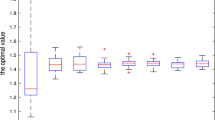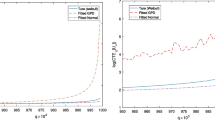Abstract
This paper has a further study on the insurer’s most unfavorable deductibles and coverage limits for interdependent random losses in the context of the zero-utility premium. For multiple random losses equipped with Archimedean copulas, we conduct stochastic comparison on the insurer’s most unfavorable deductibles and most unfavorable coverage limits, respectively. Also, we build the most unfavorable deductibles for risk-averse insurers. The main results extend and complement those related ones in the literature.

Similar content being viewed by others
Notes
A function \(\varphi \) defined on \((0,+\infty )\) is said to be n-monotone if it is differentiable there up to the order \(n-2\) and the derivatives satisfy \((-1)^k\varphi ^{(k)}(t)\ge 0\), for \(k=1,\ldots ,n-2\) and any \(t\in (0,+\infty )\), and further if \((-1)^{(n-2)}\varphi ^{(n-2)}(t)\) is decreasing and convex; here \(\varphi ^{(0)}(t)=\varphi (t)\) and \(\varphi ^{(k)}(t)\) be the kth order derivative evaluated at t.
A random vector \(\varvec{X}\) is said to be positively lower orthant dependent (PLOD) if
$$\begin{aligned} {\mathrm {P}}\bigg (\bigcap _{i=1}^n\{X_i\le x_i\}\bigg )\ge \prod _{i=1}^n{\mathrm {P}}(X_i\le x_i), \qquad \text{ for } \text{ all } x_i, i=1,\ldots ,n. \end{aligned}$$For more we refer readers to Denuit et al. (2005).
A random vector \(\varvec{X}\in {\mathbb {R}}^n\) is comonotonic if \({\mathrm {P}}(\varvec{X}\in B)=1\) for some comonotone subset \(B\in {\mathbb {R}}^n\) such that either \(x_i\le y_i\) or \(x_i\ge y_i\) for \(i=1,\ldots ,n\) whenever both \((x_1,\ldots ,x_n)\) and \((y_1,\ldots ,y_n)\) in B. \(\varvec{X}\) with \(X_1\le _\text {st}\cdots \le _\text {st}X_n\).
References
Asimit, A. V., Vernic, R., & Zitikis, R. (2013). Evaluating risk measures and capital allocations based on multi-losses driven by a heavy-tailed background risk: The multivariate Pareto-II model. Risks, 1, 14–33.
Barlow, R. E., & Proschan, F. (1981). Statistical theory of reliability and life testing. Silver Spring, Maryland: To Begin With.
Cai, J., & Wei, W. (2014). Some new notions of dependence with applications in optimal allocation problems. Insurance: Mathematics and Economics, 55, 200–209.
Cheung, K. C. (2007). Optimal allocation of upper limits and deductibles. Insurance: Mathematics and Economics, 41, 382–391.
Denuit, M., Dhaene, J., Goovaerts, M., & Kaas, R. (2005). Actuarial theory for dependent risks. New York: Wiley.
Finkelshtain, I., Kella, O., & Scarsini, M. (1999). On risk aversion with two risks. Journal of Mathematical Economics, 31, 239–250.
Franke, G., Schlesinger, H., & Stapleton, R. C. (2011). Risk taking with additive and multiplicative background risks. Journal of Economic Theory, 146, 1547–1568.
Hu, S., & Wang, R. (2014). Stochastic comparisons and optimal allocation for policy limits and deductibles. Communications in Statistics—Theory and Methods, 43, 151–164.
Hua, L., & Cheung, K. C. (2008a). Stochastic orders of scalar products with applications. Insurance: Mathematics and Economics, 42, 865–872.
Hua, L., & Cheung, K. C. (2008b). Worst allocations of coverage limits and deductibles. Insurance: Mathematics and Economics, 43, 93–98.
Kaas, R., Van Heerwaarden, A. E., & Goovaerts, M. J. (1994). Ordering of actuarial risks. Amsterdam: Caire Education Series.
Krzemienowski, A., & Szymczyk, S. (2016). Portfolio optimization with a copula-based extension of conditional value-at-risk. Annals of Operations Research, 237, 219–236.
Li, H., & Li, X. (2013). Stochastic orders in reliability and risk. New York: Springer.
Li, X., & You, Y. (2012). On allocation of upper limits and deductibles with dependent frequencies and comonotonic severities. Insurance: Mathematics and Economics, 50, 423–429.
Li, X., & You, Y. (2014). A note on allocation of portfolio shares of random assets with Archimedean copula. Annals of Operations Research, 212, 155–167.
Li, X., & You, Y. (2015). Permutation monotone functions of random vector with applications in financial and actuarial risk management. Advances in Applied Probability, 47, 270–291.
Lu, Zh Y, & Meng, L. L. (2011). Stochastic comparisons for allocations of upper limits and deductibles with applications. Insurance: Mathematics and Economics, 48, 338–343.
Marshall, A. W., & Olkin, I. (1979). Inequalities: Theory of majorization and its applications. New York: Academic Press.
McNeil, A. J., Frey, R., & Embrechts, P. (2015). Quantitative risks management (2nd ed.). Princeton: Princeton University Press.
McNeil, A. J., & Nes̆lehová, J. (2009). Multivariate Archimedean copulas, \(d\)-monotone functions and \(l_1\)-norm symmetric distributions. The Annals of Statistics, 37(5B), 3059–3097.
Nelsen, B. R. (2006). An introduction to copula. New York: Springer.
Pratt, J. W. (1988). Aversion to one risk in the presence of others. Journal of Risk and Uncertainty, 1, 395–413.
Sklar, A. (1959). Fonctions de rèpartition á n dimensions et leurs marges. Publicationis de l’Institut de Statistique de Paris, 8, 229–231.
Shaked, M., & Shanthikumar, J. G. (2007). Stochastic orders. New York: Springer.
Stoyanov, S., Racheva-Iotova, B., Rachev, S. T., & Fabozzi, F. J. (2010). Stochastic models for risk estimation in volatile markets: a survey. Annals of Operations Research, 176, 293–309.
Tong, Y. L. (1980). Probability inequalities in multivariate distributions. Cambridge: Academic Press.
Tsanakas, A. (2009). To split or not to split: capital allocation with convex risk measures. Insurance: Mathematics and Economics, 44, 268–277.
You, Y., & Li, X. (2014). Optimal capital allocations to interdependent actuarial risks. Insurance: Mathematics and Economics, 57, 104–113.
You, Y., & Li, X. (2016). Ordering scalar products with applications in financial engineering and actuarial science. Journal of Applied Probability, 53, 47–56.
Zhuang, W., Chen, Z., & Hu, T. (2009). Optimal allocation of policy limits and deductibles under distortion risk measures. Insurance: Mathematics and Economics, 44, 409–414.
Author information
Authors and Affiliations
Corresponding author
Additional information
Dr. Yinping You’s research is supported by the National Natural Science Foundation of China (11526093).
Rights and permissions
About this article
Cite this article
You, Y., Li, X. Most unfavorable deductibles and coverage limits for multiple random risks with Archimedean copulas. Ann Oper Res 259, 485–501 (2017). https://doi.org/10.1007/s10479-017-2537-9
Published:
Issue Date:
DOI: https://doi.org/10.1007/s10479-017-2537-9




